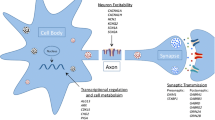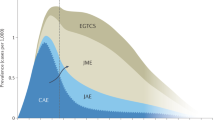Abstract
The main clinical and bioelectrical features of the benign partial epilepsies and related conditions are described. Based on highly selected groups, the definition of these suggested syndromes disregards the considerable overlap between borderline and intermediate cases. To understand the great phenotypic variability of these epilepsies, the complexity of causal especially genetic factors must be considered. Different genetic traits, expressed in certain EEG patterns, determine the level of cerebral excitability. These hereditary variables are widespread in the general population. Most are polygenic, focal sharp waves possibly autosomal dominant. In individuals, the coincidence of different traits with little or no clinical significance, results in additive effects lowering the seizure threshold and raising the risk of clinical manifestation. The complexity of causal factors, which, potentially include organic brain lesions, account for the wide spectrum of epileptic and non-epileptic conditions ranging from mild selective performance deficits to complex psychomental retardation, and from simple rolandic epilepsy to severe epilepsies with minor seizures or bioelectrical status. These conditions are not “syndromes” in the stricter sense, but sets of variably weighted symptoms of a complex pathogenetic background. A genetic disposition to focal anomalies of brain function is of decisive importance. The biological background is as of yet unknown. The marked agedependency of symptoms and almost regular disappearence of seizures and EEG abnormalities at puberty justify the assumption of an hereditary impairment of brain maturation. The hypothesis of autosomal dominant inheritance awaits appraisal by studies of larger populations and quantitative genetic approaches.
Similar content being viewed by others
Abbreviations
- ESES:
-
electrical status epilepticus during sleep
- HIBM:
-
hereditary impairment of brain maturation
References
Aicardi J, Chevrie JJ (1982) Atypical benign partial epilepsy of childhood. Dev Med Child Neurol 24:281–292
Aicardi J, Newton R (1987) Clinical findings in children with occipital spike wave complexes suppressed by eye opening. In: Andermann F, Lugaresi F (eds) Migraine and epilepsy, Butterworth, Boston London Durban, pp 111–124
Andermann E (1982) Multifactorial inheritance of generalized and focal epilepsy. In: Anderson VE, Hauser WA, Penry JK, Sing CF (eds) Genetic basis of the epilepsies. Raven Press, New York, pp 355–374
Baier WK, Doose H (1987) Interdependence of different genetic EEG patterns in siblings of epileptic patients. Electroencephalogr Clin Neurophysiol 66:483–488
Bancaud, J, Collomb J, Dell MB (1958) Les pointes rolandiques: Un symptóme EEG propre à l'enfant. Rev Neurol (Paris) 99:206–209
Beaumanoir A (1985) The Landau-Kleffner syndrome. In: Roger J, Dravet C, Bureau M, Dreyfuss FE, Wolf P (eds) Epileptic syndromes in infancy, childhood and adolescence. Libbey Eurotext, London Paris, pp 181–191
Beaumanoir A, Ballis T, Varfis G, Ansari K (1974) Benign epilepsy of childhood with rolandic spikes. Epilepsia 15:301–315
Benninger CK, Matthis P, Scheffner D (1982) EEG findings in children of epileptic parents. In: Anderson VE, Hauser WA, Penry JK, Sing CF (eds) Genetic basis of the epilepsies. Raven Press, New York, pp 95–99
Berges J, Harrison A, Lairy GC, Stambak M (1968) L'EEG de l'enfant dyspraxique. Electroencephalogr Clin Neurophysiol 25:208–220
Bercovic SF, Andermann F, Andermann E, Gloor P (1987) Concepts of absence epilepsies: discrete syndromes or biological continuum? Neurology 37:993–1000
Blume WT (1978) Clinical and electroencephalographic correlates of the multiple independent spike foci pattern in children. Ann Neurol 4:541–547
Bray PF, Wiser WC (1964) Evidence for a genetic etiology of temporal-central abnormalities in focal epilepsy. N Engl J Med 271:926–933
Bray PF, Wiser WC (1965) The relation of focal to diffuse epileptiform EEG discharges in genetic epilepsy. Arch Neurol 13:223–237
Cavazutti GB, Cappella L, Nalin A (1980) Longitudinal study of epileptiform EEG patterns in normal children. Epilepsia 21:43–55
Commission in classification and terminology of the International League Against Epilepsy (1985) Proposal for classification of epilepsies and epileptic syndromes. Epilepsia 26:268–278
Dalla Bernardina B, Chiamenti C, Capovilla G, Trevisan E (1985) Benign partial epilepsy with affective symptoms. In: Roger J, Dravet C, Bureau M, Dreyfuss FE, Wolf P (eds) Epileptic syndromes in infancy, childhood and adolescence. Libbey Eurotext, London Paris, pp 171–175
Dalla Bernardina B, Chiamenti C, Capovilla G, Colamaria V (1985) Benign partial epilepsies in childhood. In: Roger J, Dravet C, Bureau M, Dreyfuss FE, Wolf P (eds) Epileptic syndromes in infancy, childhood and adolescence. Libbey Eurotext, London Paris, pp 137–149
Doose H (1989) Symptomatology in children with focal sharp waves of proven genetic origin. Eur J Pediatr 149:210–215
Doose H, Baier WK (1987) Genetic factors in epilepsies with primarily generalized minor seizures. Neuropediatrics [Suppl] 18:1–64
Doose H, Baier WK (1988) Theta rhythms in the EEG—a genetic trait. Brain Dev 10:347–354
Doose H, Baier WK (1989) Generalized spikes and waves. In: Beck-Mannagetta G, Anderson VE, Doose H, Janz D (eds) Genetics of the epilepsies. Springer, Berlin Heidelberg New York, pp 95–103
Doose H, Baier WK (1989) Genetic aspects of childhood epilepsy. Cleve Clin J Med 56[Suppl] S 105–110
Doose H, Gerken H (1973) On the genetics of EEG-anomalies. IV. Photoconvulsive reaction. Neuropaediatrie 4:162–171
Doose H, Voelzke E (1979) Petit mal-status in early childhood and dementia. Neuropaediatrie 10:10–14
Doose H, Voelzke E, Petersen CE, Herzberger E (1966) Fieberkrämpfe und Epilepsie. Arch Psychiat Nervenkr 208:400–412, 413–432
Doose H, Genken H, Voelzke E (1972) On the genetics of EEG-anomalies. I. Abnormal theta rhythms. Neuropaediatrie 3:386–401
Doose H, Ritter K, Voelzke E (1983) EEG longitudinal studies in febrile convulsions. Genetic aspects. Neuropediatrics 14:81–87
Doose H, Baier WK, Ernst JP, Tuxhorn J, Völzke E (1988) Benign partial epilepsy — treatment with sulthiam (OspolotR). Dev Med Child Neurol 30:683–684
Eckel U: Monozygote Zwillinge mit Rolandischer Epilepsie. (In preparation)
Edwards JH (1975) Familial predisposition in man. Br Med Bull 25:58–64
Eeg-Olofsson O, Petersèn I, Sellden U (1971) The development of the electroencephalogram in normal children from the age of 1 through 15 years. Paroxysmal activity. Neuropaediatrie 2:375–404
Elger CE, Speckmann EJ (1983) Penicillin-induced epileptic foci in the motor cortex: vertical inhibition. Electroencephalogr Clin Neurophysiol 56:604–622
Elger CE, Speckmann EJ, Prohaska O, Caspers H (1981) Pattern of intracortical distribution during focal interictal epileptiform discharges (FIED) and its relation to spinal field potentials in the rat. Electroencephalogr Clin Neurophysiol 51:393–402
Fois A, Borcheresi S, Luti E (1968) Clinical correlates of focal epileptic discharges in children without seizures. A study of 110 cases. Helv Paediatr Acta 23:257–265
Frantzen EM, Lennox-Buchthal M, Nygaard A, Stene J (1970) A genetic study of febrile convulsions. Neurology 20:909–917
Fukuyama Y, Kagawa K, Tanaka K (1979) A genetic study of febrile convulsions. Eur Neurol 18:166–182
Gastaut H (1982) A new type of epilepsy: benign partial epilepsy of childhood with occipital spike-waves. Clin Electroencephalogr 13:13–22
Gastaut H (1985) Benign epilepsy of childhood with occipital paroxysms. In: Roger J, Dravet C, Bureau M, Dreyfuss FE, Wolf P (eds) Epileptic syndromes in infancy, childhood and adolescence. Libbey, London Paris, pp 159–170
Gastaut H, Zifkin BG (1987) Benign epilepsy of childhood with occipital spike and wave complexes. In: Andermann F, Lugaresi E (eds) Migraine and epilepsy. Butterworth, Boston London Durban, pp 47–81
Gerken H (1971) Ueber konstitutionelle EEG-Anomalien bei kindlichen Epilepsien. Habilitation Thesis, Kiel University, Kiel
Gerken H, Doose H (1972) On the genetics of EEG-Anomalies. II. Occipital 2–4/s-rhythms. Neuropaediatrie 3:437–454
Gerken H, Doose H (1973) On the genetics of EEG anomalies. III. Spikes and waves in the resting record and/or during hyperventilation. Neuropaediatrie 4:88–97
Gibbs EL, Gibbs FA (1959) Good prognosis of midtemporal epilepsy. Epilepsia 1:448–453
Gibbs EL, Gillen HW, Gibbs FA (1954) Disappearence and migration of epileptic foci in childhood. Am J Dis Child 88:596–603
Green JB (1961) Association of behavior disorder with an electroencephalographic focus in children without seizures. Neurology 11:337–344
Gundel A, Doose H (1986) Genetic EEG patterns in febrile convulsions — a multivariate analysis. Neuropediatrics 17:3–6
Heijbel J, Blom S, Rasmuson M (1975) Benign epilepsy of childhood with centro-tempral EEG foci. A genetic study. Epilepsia 16:285–293
Heller T (1908) Über Dementia infantilis (Verblödungsprozeß im Kindesalter). Z Jug Schwachsinn 2:17–28
Kajitani T, Nakamura M, Ueoka K, Kobuchi S (1980) Three pairs of monozygotic twins with rolandic discharges. In: Wada JA, Penry JK (eds) Advances in epileptology. The 10th Epilepsy International Symposium, Raven Press, New York, pp 171–175
Kajitani T, Keoka K, Nakamura M, Kumanomidou Y (1981) Febrile convulsions and rolandic discharges. Brain Dev 3:351–359
Kennedy A, Hill D (1942) Dementia infantilis with cortical dysrhythmia. Arch Dis Child 17:122–129
Lairy GC, Remond A, Lesevre N, Rieger H (1966) Introduction e l'etude EEG des fonctions visuomotrices chez l'enfant. Rev Neurol 115:15–59
Lennox WG, Gibbs EL, Gibbs FA (1939) The inheritance of epilepsy as revealed by the electroencephalograph. JAMA 113:1002–1003
Lerman P, Kivity-Ephraim S (1981) Focal epileptic EEG-discharges in children not suffering from clinical epilepsy: etiology, clinical significance, and management. Epilepsia 22:551–558
Lüders H, Lesser RP, Dinner DS, Morris III HH (1987) In: Lüders H, Lesser RP (eds) Benign focal epilepsy of childhood. Epilepsy: electroclinical syndromes. Springer, Berlin Heidelberg New York, pp 303–346
Meldrum BS, Papy JJ, Toure MF, Brierly JB (1975) four models for studying cerebral lesions secondary to epileptic seizures. In: Meldrum BS, Marsden CD (eds) Advances in neurology, vol 10. Raven Press, New York, pp 147–161
Metrakos K, Metrakos JD (1961) Genetics of convulsive disorders. II. Genetic and electroencephalographic studies in centrencephalic epilepsy. Neurology 11:464–483
Niedermeyer E (1981) Complexities of primary generalized epilepsy. Clin Electroencephalogr 12:177–191
Ono T, Kumashiro H, Choji K (1982) Monozygotic twins with rolandic discharges without seizures. Brain Dev 4:246
Ottman R, Hauser WA, Susser M (1985) Genetic and maternal influences on susceptibility to seizures. Am J Epidemiol 122:923–939
Patry G, Lyagoubi S, Tassinari CA (1971) Subclinical „electrical status epilepticus” induced by sleep in children. Arch Neurol 24:242–252
Rich SS, Annegers JF, Hauser WA, Anderson VE (1987) Complex segregation analysis of febrile convulsions. Am J Hum Genet 41:249–257
Roger J, Dravet C, Bureau M, Dreifuss FE, Wolf P (eds) (1985) Epileptic syndromes in infancy, childhood and adolescence. Libbey Eurotext, London Paris
Schulz M, Dietz A Somatosensorisch evozierte Potentiale bei Rolandischer Epilepsie. (In preparation)
Smith JMB, Kellaway P (1964) Central (rolandic) foci in children: an analysis of 200 cases. Electroencephalogr Clin Neurophysiol 17:451–452
Spranger J (1989) Krankheit, Syndrom, Sequenz. Monatsschr Kinderheilkd 137:2–7
Stollhhoff K, Albani M, Landau-Kleffner-Syndrome — a family study. (In preparation)
Tassinari CA, Bureau M, Dravet C, Dalla Bernardina B, Roger J (1985) Epilepsy with continuous spikes and waves during slow sleep — otherwise described as ESES (epilepsy with electrical status epilepticus during slow sleep). In: Roger J, Dravet C, Bureau M, Dreyfuss FE, Wolf P (eds) Epileptic syndromes in infancy, childhood and adolescence. Libbey Eurotext, London Paris, pp 194–204
Tsuboi T (1977) Genetic aspects of febrile convulsions. Hum Genet 38:169–173
Vogel F (1970) The genetic basis of the normal human electroencephalogram (EEG). Humangenetik 10:91–114
Wasterlain CG (1974) Inhibition of cerebral protein synthesis by epileptic seizures without motor manifestations. Neurology 30:175–180
Author information
Authors and Affiliations
Rights and permissions
About this article
Cite this article
Doose, H., Baier, W.K. Benign partial epilepsy and related conditions: Multifactorial pathogenesis with hereditary impairment of brain maturation. Eur J Pediatr 149, 152–158 (1989). https://doi.org/10.1007/BF01958268
Received:
Revised:
Issue Date:
DOI: https://doi.org/10.1007/BF01958268




